#recording bands
Explore tagged Tumblr posts
Text
A DIP IN THE MUSE KITCHEN SINK
A wonderfully in-depth interview from 2013 with Muse producers/engineers Adrian Bushby and Tomasso Colliva, who worked on The 2nd Law. The interview goes into the recording of every part of the album, vocals and instruments, and as someone who has been teching bands for live radio sessions, you bet I'm reading every word of it :). Source.
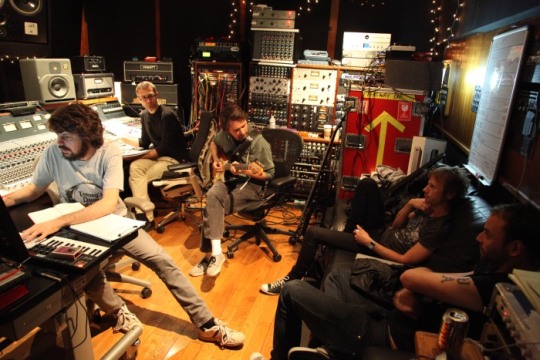
"Tomasso Colliva, Adrian Bushby and Muse at East West Studios in LA. Photo by Tom Kirk"
Muse is arguably the ultimate 21st century kitchen-sink act. Adjectives like “overblown,” “over the top,” “ridiculous,” and “pompous” are regularly used in describing the band’s music, and the British trio’s master stroke is that they have turned these normally damning qualifications into badges of honour. Muse’s many fans adore the band’s bombastic intensity, the classical influences, the juxtaposition of heavily-distorted-in-your-face-over-compressed-monolithic rock with orchestras, choirs, diminished chords, key changes, and many other divergent ingredients, taking things to the limit and, well, far beyond. It makes the band’s music a love-it-or-hate it affair, but with their six studio albums selling 15 million copies to date the trio doesn’t have to worry about the nay-sayers.
Late last year saw the release of The 2nd Law, Muse’s sixth studio album and the follow-up to the commercially very successful The Resistance (2009). While the download era has seen Muse’s album sales are gradually declining, in line with those of any other act with any kind of longevity, in terms of chart figures the new album did almost as well as The Resistance, reaching to #1 in the UK and NZ, and #2 in the US and Oz. The band has gone on record saying that they were “drawing a line under a certain period” would do “something radically different” on the new album, and quoted influences of dubstep and electronic music as inspirations for a new direction. The 2nd Law does have some different touches in that it sounds more electronic than previous Muse albums and there are indeed some dub-step elements thrown in on a couple of songs, plus in other places the rather un-Muse sound of an R&B brass section. But overall it’s very recognisably Muse, as ever alternating moments of spine-tingling beauty with the more mundane, and overall admirably succeeding in obliterating the divide between the sublime and the ridiculous.
Unsurprisingly, perhaps, the kitchen-sink approach isn’t only a central pillar of Muse’s music, it’s also at the heart of their approach to recording it. Almost all their albums have been big budget productions recorded in ways that are reminiscent of the good/bad old days of the 80s and 90s, when spending months if not years and hundreds of thousands of dollars on recording an album was the norm rather than the exception. Apart from the band’s low-budget debut album Showbiz (1999) and The Resistance, which was recorded over a period of a year at guitarist/pianist/singer and main song writer Matt Bellamy’s own studio near Lake Como in Italy, their other albums were made over a prolonged period of time in a range of top quality studios located in different countries. The 2nd Law is a return to this way of working, as it was recorded from November 2011 to May 2011, mostly at Air Studios in London, with a couple of months in Los Angeles to record at East West, Capitol, and Shangri-La, and two string sessions in Milan at Officine Meccaniche (for the tracks “Explorers” and “Prelude”).
At the controls for The 2nd Law were Adrian Bushby and Tommaso Colliva, hailing from the UK and Italy respectively. Bushby also engineered The Resistance, with help from Colliva, and their accounts of the goings-on during the making of The 2nd Law are surprising in several respects, not least the fact that Muse turned Air studio 1 for a whopping six weeks into what surely must have been the world’s most expensive rehearsal space from mid-September to November 2011, and they then continued the recording process as described above. And that was before three of the world’s top mixers, Chris Lord-Alge, ‘Spike’ Stent, and Rich Costey, were brought into action. If the Muse guys are worried about declining album sales and how they’ll continue to generate revenue, their working methods don’t show it. There were other elements of excess, for example recording the drums with a PA system, the hundreds of tracks that were recorded for each session, the wealth of additional musicians and singers that were recorded, and so on. This was, undoubtedly, a Muse project…
On the phone from Milan, Colliva took the story from the top. After Muse, he’s probably the person with the deepest insights into the band’s working methods, because he’s worked with them since 2005, when he helped out with the recordings of Black Holes and Revelations (2006). In addition to working on every Muse album since, he also played a central role in building Bellamy’s Lake Como studio, did the pre-production for the The Resistance tour and also is the band’s live Pro Tools engineer. “I used to be chief engineer at Officine Meccaniche,” added Colliva, “which is Milan’s largest recording studio and one of Italy’s top facilities. Muse came to record there at the end of 2005, and because I was the only person who spoke English I was asked to assist them. I ended up recording a bunch of things. Because Matthew had an Italian girlfriend at the time, he bought a house in Italy, near Lake Como, and I helped him turn the rehearsal space in his villa into a fully-fledged studio, with an SSL 4048 G+ series desk and tons of outboard, where we recorded The Resistance.”
Bellamy and his Italian girlfriend split up towards the end of 2009 and the Briton moved back to the UK. “For the new album the band wanted to record in London,” elaborated Colliva. “Like with The Resistance, they wanted to do pre-production using Pro Tools. They had done this at Matthew’s Lake Como studio for that album, but for the new album they asked me to set up everything they needed at Air. This took me three or four days. They wanted a big set-up, with quite a few microphones, and all signal paths and Pro Tools sessions ready to go. They like to be left alone during this phase, which meant that I set Pro Tools up so that all they had to do was open up a template that gave them access to every instrument at the touch of a button. They didn’t have to think about the technical side of things, and this allowed them to sketch out ideas and arrangements very quickly, and if they stumbled on new ideas these were also captured. There was an assistant if they needed some support, and other than that I was always on call via telephone. Every two weeks I’d go to London to check that everything worked and that the recordings were OK. In November Adrian and I then joined them in the studio to record everything properly.”

"Tommaso Colliva in Brooklyn Recordings Studios NYC. Phot by Francesco Balatti"
The working method described by Colliva sounds sensible enough… until that last sentence. Two things jar: first of all, why spend two months recording what essentially are demos in one of the most expensive studios in the world? Air wouldn’t say, but comparing it with the world’s other top facilities, Air Studio 1, with its 72 Channel custom Neve/Focusrite desk (it has 56 Neve 31106 and 16 Focusrite ISA110 channels) is likely to cost north of A$1000 per day. Spending A$40.000 (or whatever deal the studio offered) on six weeks rehearsal space, however deluxe, really is a throwback to the excess-all-areas eighties and nineties and not very 21st century at all. Moreover, aren’t demos a thing of the past? Isn’t the whole point of the DAW that anyone can record master-quality material anywhere, and going into a commercial studio is purely a matter of using these studios’ specific qualities (acoustics, monitoring, outboard)?
Colliva was almost able to hear the rising eyebrows on the other end of the telephone, and explained, “The band wanted to be able to do things in a very modern way, including the abilities to edit things and try different arrangement in Pro Tools. But they wanted to be able to do this without anyone around. If Adrian and I had been there, it would have been more expensive, and also, the days would have been standard production days during which they’d have felt obliged to go to the studio for at least eight hours a day. Instead they could go to the studio whenever they wanted, whether just for two hours or longer. It gave them a lot of freedom. It’s true that with the mics and signal paths that I had set up it would be possible to track any band and get top quality results, but when we switched to the actual recording process in November, with Adrian and I there, we did really step up things. We changed the miking of the drum kit, we put up many more room mics, we used different guitar and bass amplifiers, and we used a PA kit to enhance the drum sound. In September and October the band was busy writing sketching out arrangements, and in November it was a matter of: ‘OK we now know what the songs are, now let’s get the exact sounds we’re after.”
“Yes, we did replace almost everything they had recorded during the rehearsal phase, apart from some of the soft synth sounds, because Matthew had lived with them for months, and it would have been hard to abandon them. The main three soft synths they used were Pro Tools’ Vacuum, Native Instruments’ Massive, Rob Papen’s Predator, and we also had a separate computer dedicated to samples from VSL and East West. Many of the drum samples came from Battery, and East West’s Stormdrums and RockDrums, with the last one only for demoing. With regards to using the PA system to augment the drum sound, it’s something that I had done when working with Afterhours, one of Italy’s leading alternative rock bands, and when Matthew asked me for ideas, I suggested it to him. The set-up consisted of Roland triggers on the drum kit connected to a Roland TMC 6 trigger to midi converter, that fed a MacBook running Native Instruments’ Battery, with our own sounds in it. We ran these through the PA, and recorded them via the drum kit microphones together with the live kit.”
During the seven months of tracking, Bushby and Colliva had a fairly well-defined role division, with Bushby mainly responsible for the actual recording, ie mic choices and placements and signal paths, and the Italian manning the Pro Tools rig. “I was in fact doing two things,” adds Colliva, “one was handling everything that was digital, meaning Pro Tools, samples, synths and so on, and the other thing was coordinating everything else that related to the logistics side of production, meaning moving instruments around, making sure everything that the band needed was there, and so on. That was a lot of work when we were in LA, because we didn’t have the same degree of support from Muse’s management and the bands touring crew was faraway.”
Colliva’s logistic contributions were one reason for his additional production credit, which was also given the Bushby. The Briton added, “I think we received the additional production credits because recording The 2nd Law was more a group effort than The Resistance had been. We were five in a room, and when decisions had to be made, everybody put in their opinions.” Bushby is a London-based engineer, mixer and producer, who has worked with My Bloody Valentine, New Order, U2, Placebo, Smashing Pumpkins, Dashboard Confessional, Depeche Mode, and the Foo Fighters, and who has won two Grammy Awards, one for his engineering work on The Resistance and one for recording the Foo Fighters’ Echoes, Silence, Patience, Grace. He has a formidable reputation for his awareness of sound, and he reckons that Muse involved him “for the sonic point of view.”
From his state of the art studio in North London (see sidebar), Adrian Bushby gives his side of the story of the goings-on during the making of The 2nd Law, first of all clarifying that, for him at least, the seven-month production period for the album, November 2011 – late May 2012, wasn’t a nose-to-the-grindstone, 16-hours a day, 7/7 affair. “It was always a matter of work for two or three weeks and then I had a few weeks off. Having breaks like that meant that we didn’t get too tired. The approach was a bit different than with The Resistance, because when I arrived in Italy for work on recording that album they had three songs ready to go and the rest was very sketchy. But when I turned up at Air, there was a whole wall with write-ups and details of tracks that were ready to be recorded. In either case Matt always knows what’s going on, which is incredible, considering the complexity of their music. He always knows what has been done and what still has to be done, and where he is going.”
“When they were rehearsing and doing preproduction, they pretty much record the songs as a band, with everything miked up as if they were tracking for real. When we were recording them they regularly played as a three-piece but they also did many individual overdubs. We used the recordings they’d done during preproduction as a template. Sometimes we used the guitars and pianos that Matt had recorded for the demos as backdrops for Chris [Wolstenholme, bass] and Dom [Dominic Howard, drums] to play to. We made sure that everything was well separated, so we could overdub without spill. Chris’s and Matt’s amps were in different booths and rooms, so everything was very isolated. Also, the band works with in-ear monitors, which meant that we didn’t have any problems with things blaring from monitors. They control their own headphone mix with a 16-channel mix system by Aviom. They also use that live, and they’re really happy with it, which made my job a lot easier!”
According to Bushby, on his and Colliva’s arrival in November 2011, one of the first things they did was adjust the recording space, “The live room has a glass dividing wall, and during preproduction they had closed it and placed the drums behind it so the drums didn’t sound too loud in the room. But for some reason the drums sounded really uncontrolled with that partition closed, I think because there’s so much glass. It sounded really big and trashy with no focus on the cymbals. So we opened the doors and turned it into one big room, which sounded much better. It gave the extra close microphones on the kit a lot more focus. In general we carried on from where they had left off during preproduction, trying out new set-ups with different amps, and putting up additional microphones for a more in-depth sound. We first concentrated on getting the drums and bass tracks up and running, experimenting with many different sounds in the process.”
RECORDING DRUMS
Adrian Bushby: “Whilst the band had been demo-ing, Dom had treated many of the drum tracks with plugin EQs, going for very bright and attacky sounds. I decided to go along with that vibe for the drums. But instead of trying to record the drums very flat and natural and then EQ everything afterwards to get the sound they were after, I tried to get the sounds they wanted as they went down. I recorded the drums with a whole range of microphones, generally the same as most people use, but I did try various different ones. I always tried to have something interesting and different and set up lots of different mics in different places and gave them different treatments. Sometimes I used them all, sometimes only a few. I had some AKG D90’s floating around that worked really well, a Russian Lomo mic, which is one of mine, as well as an SM57 and an AKG414 on the floor behind the kit. There also was a Sennheiser, I can’t remember the model number, but it looks like a bullet mic, and it sounded great when put through an amp, just pulling it back from distorting. The drums for the track ‘Unsustainable’ in particular were recorded with many unusual microphones.”
“For more regular sounds I generally had a couple of mics on the kick, one of them the Shure SM91, as well as a 47 slightly outside the kick and an NS10 sub. The snare mics were an SM57 on top and an AKG414 underneath, and I also had a contact mic on the floor. I recorded the toms with 421’s on top and Neumann FET47’s underneath and I had AKG 451’s for the overheads, which I hadn’t used for a long time, but they gave the cymbals in that big room at Air some more focus. There also were a couple of Sennheiser MKH40 mics for closer room sounds and Schoeps from the orchestral set-up at Air for ambience, stuck as far and high back in the room as possible. Like on the previous record we had a piano in the room, and I used the piano mics for additional drum ambience. It’s something that I discovered by accident and it works really well. Because of the resonance of the piano you get some unusual ambience that you don’t get from normal drum ambience mics.”
“Regarding the signal paths, generally speaking everything went through the Neve 31106 mic pres in the Air desk, with some Neve EQ and Pultec EQ on the bass drum and the snare drum groups. I don’t like to compress the bass drum too much when recording, and the snare drum had some compression from a Distressor, but again nothing drastic. Most of the compression was on the room mics. I love compression on room mics, and we initially went for quite a compressed drum sound, but when we switched the PA on it obviously squashed everything down, so we tried to keep the room mics more open this time round. There were just a few close drum mics that were treated with some extra compression, while the room mics generally remained quite open.”
“The PA system was in the room behind Dom and pumped out quite synthetic, dancey sounds, really loud, while he was playing. I’d never done that before. The PA shifted a lot more air than just the acoustic kit, so we got this huge pumping sound in the room, which was very effective. The point of using the PA was to create a more dancey sound for the live kit, because they wanted to incorporate this dubstep thing. I miked up the kit as usual and obviously the room mics were going to pick up most of the PA. The close mics also picked something up, and altogether this added up to a bigger, very interesting sound. We occasionally put live bass and snare drum sounds through the PA, but mostly they were the synthesized sounds from Battery. We also recorded these Battery sounds dry, but generally speaking only used the sounds that had gone through the PA and that were picked up by the drum and room mics.”
RECORDING BASS
Colliva: “Both Matt and Chris are very fond of their live sound, but I always feel that their live setups include pieces that are not really needed in the studio, so the challenge was for them to have the same functionality in the studio, but with shorter signal chains and better sound quality. I had a Radial JD7 Injector splitter, and we would have three chains for the bass, one clean channel via his Markbass amplifiers [MoMark and SD1200], and two distorted channels, one with distortion coming from some kind of Big Muff or Animato pedal sound and the other channel would have a more fuzz-like sound coming from fuzz pedals by ZVex, like the Mastotron or Woolly Mammoth. There would also have been a fourth chain with a hot DI if we wanted an aggressive sound. Chris may also have used pedals, which we automated if they were midi controllable. We’d do a take with Chris playing via a wah-wah pedal and getting it roughly the way he wanted it to sound, and we then sent the DI through a pedal that we automated to make the wah-wah sharper and faster than a human could play it. We did similar things with Matt’s guitar.”
Bushby: “Chris’s sound is incredible. He knows how to get his sounds, and that makes it much easier when you are recording him. The Markbass set-up covered the clean sounds, I think we had two different heads and cabs on which I had an AKG D19 and an RE20 plus an NS10 sub, and they all came into the Neve desk with an 1176 on the clean bass group. The more distorted bass sound was played via two vintage eighties Marshall DBS heads going into two different cabs, placed in the back of the room, and on them I had a Shure SM7 and another RE20, panned left and right, and a couple of Neve compressors just touching things. When you have that much distortion on the track, you don’t really need compression. I didn’t want to squash the life out of the sound. Depending on the track we would sometimes changes pedals and triggered different effects from the computer. We generally speaking didn’t use the DI.”
RECORDING GUITARS
Bushby: “Matt used Diesel V4, AC30, Marshall 1959HW and HiWatt 100 amplifiers and Mills 4×12 cabinets and a Roland JC120 and a couple of Fender combos as well, like a Fender Twin. I’d normally have two mics on the speakers, like a Shure SM57, a 421, a Neumann FET, a Royer 121 (Matt really likes the sound of that), an AKG 414, or an AEA ribbon. The latter works really well because it can handle quite a lot of level. Generally every amp would have a Shure 57 and whatever went with it to taste. We also had a couple of Neumann 87 room mics, which usually picked up the 4×12’s, because they were in the big room, while other amps were screened away or in other rooms. I tended to use the desk Neve mic pres, and then a Pultec or AER EQ across the group, adding a bit more treble and bass overall. I EQ-ed the individual mics as well as the overall summed sound.”
KEYBOARDS
Bushby: “There were many keyboards in this album, with most of them soft synths. They went sort of Native Instrument crazy during the recordings. These generally speaking remained in the box, so for me the keyboards were mainly a question of miking up the piano and the Fender Rhodes. We went for the same set-up as with the previous record, with a couple of DPA mics for the nice classical sound on the piano, and also a couple of Telefunken Elam 251’s, and then I’ll generally add a couple of dynamic mics to do something unusual. These would be an SM58 in the sound hole on the sound board and this time round I also used AKG D19’s. Obviously the sound of the dynamic mics would be different than the lush, open classical sound, and I’d EQ and compress the dynamic mic sound for it to be more interesting, and pan the mics wide. When you balance them with the posh sound you can add some nice extra character. The EQ was mostly done on the desk, and any compression would have been whatever was lying around. I can’t tell you exactly how I did everything, because I just experiment until it sounds right. There is no formula. The Fender Rhodes was recorded with a couple of Neumann 67 microphones.”
STRINGS, BRASS, AND CHOIR
Bushby: “I don’t know why we went to LA, but it probably had to do with the fact that David Campbell, who did the string arrangements with Matt, is based there. I’d never done any classical recording work in LA and it was an interesting experience. The Americans were incredibly efficient, quick and focused. They’d look at a score, play it through once, and you couldn’t fault what they had done. Sometimes you did a second take, just to make sure there were no errors, and that was it. The first sessions in LA took place at Shangri-La, where Matt did guitar and Fender Rhodes overdubs, while the strings and brass were recorded in February at EastWest Studio One, which has an 80-channel Neve 8078 Console. We recorded the choir in a separate session at Capitol Studios.”
“I used Neumann 67’s above each section of the choir, and we also had this sort of Decca tree thing, with a 3-microphone set-up, and a stereo pair as well. The brass was recorded with Neumann 87’s as close mics and Telefunken Elam 251’s a bit further away for a more classical sound. I left the recording of the strings to the assistants at EastWest, because they do strings in that room day in and out and in my experience it’s generally best to go with their know-how. They used valve Neumann 47’s on the cellos and basses and Elam 251’s on the violas and violins. There was also a Decca tree and a couple of room ambience mics, but I can’t recall what they were. There was a Neve desk at EastWest, but I don’t recall the desk number anymore either. I’m too old to keep up with all the numbers. If it works, it works!”
VOCALS
“Chris recorded all his vocals at his house with the help of Paul Reeve, and Matt recorded his own vocals. You just set Matt up with some gear in another studio, and he gets on with it. It’s amazing what he does. Generally I set up a Neumann 67, a FET47, and a BeyerDynamic M88 and they went into a Neve-1176-Distressor chain and there also was an RCA ribbon mic, which went into a Mercury M72 Telefunken clone. Matt owns it, and it has a nice, warm valve sound, just like the original Telefunken. We set up these four mics with four stands and four different input chains, and he tried them out and chose which he wanted to use. He knows exactly what he wants. He’d say, ‘I’m going to do some vocals now,’ and you wouldn’t see him for the entire day, and then he’d come out with his vocals done, comped and everything.”
PUTTING IT ALL TOGETHER
Muse’s predilection for excess had a predictable effect on the size of the sessions. “Most of the sessions for this album were immense, off the scale,” remarked Bushby. “This meant that we regularly had to bounce things because we were running out of tracks and outputs. We did all the bouncing in the computer, so that the faders on the monitor side of the desk always remained at zero. We were always mixing what we had during the sessions, and this was a matter of whoever was closest to Pro Tools bouncing and balancing what was necessary. If I had just recorded four tracks of a guitar part recorded with four mics, I’d just grab them and balance them. Maybe they got tweaked later on, but the main thing for us was that we were always working to a mix, so we know whether what we have is working, and whether what we’re adding fits. I wasn’t involved in the process of selecting the guys who mixed the album, CLA, Spike and Rich. They obviously each have a different slant on things and the band wanted to use that. It’s a taste thing, and I don’t get involved. The band knows what they’re doing, and nobody needs to babysit them to make sure they’re not doing something crazy.”
There are skeptics who would dispute that. But millions will gladly second Bushby’s statement.
#long post#Muse interviews#(well sort of)#Adrian Bushy#Tomasso Colliva#recording#The 2nd Law#studio recording#2013#Muse band#Muse#technical interviews#recording bands#studio work#in studio#2012#T2L era#ookie Dom EQed the drums huh#I've been mucking about w/EQ trying to get that brighter sharper sound where live recordings can make the drums sound like dull thuds#EQing in post is well & good but having good mics and enough mics is a big one too— we use two out of a lack of lines#anywho cool read#Muse The 2nd Law
8 notes
·
View notes
Text

grammy nominations for record of the year 2025
#now and then was nominated for grammy's this year wohoo#i don't think they have a chance to win record of the year they might win rock performance though#that band broke up in 1970 and they're still being awarded lol#thank you ringo starr for your contribution#they wouldn't have been here if it were not for you#the best beatle#the beatles#paul mccartney#john lennon#george harrison#ringo starr#beatles#memes#now and then#grammys
5K notes
·
View notes
Text


#the sisters of mercy#sisters of mercy#sisters#trad goth#goth music#goth aesthetic#gothic#goth#artwork#art#merciful release#80s music#80's#80s nostalgia#1980s#80s bands#80s#80#cover art#vinyl cover#record cover#cover#80s aesthetic#eighties#80s rock#80's music#vintage#80s goth#80's goth
1K notes
·
View notes
Text
i talked about it a little bit already but i have things to say about it. for context, i was born with amniotic band syndrome. the amniotic band wrapped around my left wrist in utero and stunted the growth of my hand. i was born with about half a palm, four nubs for fingers, and a twisted half of a thumb. i can open and close my thumb and pinkie joint like a claw.
yesterday at work i had a shift in the room with 5-10 year old kids. i had my left hand hidden in my sleeve (a bad habit of mine). a kid asked if he could see my hand, and even though internally i was debating running into traffic, i said “sure you can” and showed him my hands. he stared for a moment, looking disturbed, and then said “i don’t want to look at that anymore”. that hurt to hear, but i understand that kids are new to the world and he probably didn’t mean it out of malice. i put my hand away again, told him that it was okay, and that i was just born that way.
he then went on to talk about how he knows a kid with a similar hand to mine and called it “ugly”. i told him that wasn’t a very kind thing to say and that he wouldn’t feel good if someone said that to him, and he replied that no one would say that to him—because he has “normal hands”, and he’s glad he does because otherwise he’d be “ugly”. i tried to talk with him for a bit about how everybody is born differently, but he just started talking about a girl he knows with a “messed up face” and pulled on his face to make it look droopy. i went on some more about how it wasn’t very kind to talk about people that way, but the conversation moved on to something else.
i’ve told my supervisors about it and they’re going to have a talk with his mom. what i wanted to say is this: i’m genuinely not upset with the kid. kids are young and naturally curious, and he clearly simply hasn’t been taught about disabled people and kind ways to speak to/about others. which is why i am upset with his parent(s). i know he’s encountered visibly deformed/disabled people before (he said so himself!), yet his parent(s) clearly haven’t had any kind of discussion with him about proper language and behavior. i knew from birth that some people were just different than others, but my parents still made a point to assert to be kind to and accepting of others. i wonder if adults in his life are the type of people to hush him and usher him away when he points out someone in a wheelchair. that kind of thing doesn’t teach politeness. it tells children that disabled people are an Other than can’t be acknowledged or spoken about; which, to a child, means disability must be something bad.
i’m lucky enough that this was a relatively mild incident, and that i’m a grownup with thicker skin. i’m worried about the other kids he mentioned to me. has he been talking to them this way? when i was a kid, i had other kids scream, cry, and run away at the sight of my hand. or follow me around pointing at me and laughing at me. or tell me i couldn’t do something because i was ugly or incapable or whatever. one time a girl at an arcade climbed to the top of the skeeball machine, pointed at me, and screamed at me to put my hand away and wouldn’t stop crying until she couldn’t see me anymore. another time, a kid saw my hand, screamed at the top of her lungs, and ran into my friend’s arms, crying hysterically about how i was scaring her. that second incident made me cry so hard i threw up when i got home. i can kind of laugh it off now, but having people react to me that way as a child is something i’m still getting over. why do you think i have a habit of keeping my hand in my sleeve? it just irritates me to see children that have clearly not been taught basic manners and kindness—their parents Clearly missed something pretty important .
#and for the record i consider my deformity pretty mild. maybe i’m just used to it but things like amniotic band syndrome can turn out a lot#more severe. i rarely even call myself disabled because i don’t feel like the term is applicable to me. i’m more hindered by like#my adhd anxiety depression etc than i am my hand. so for those kids to react that way to what i THINK#is a pretty small thing. makes me worry about people that are more visibly disabled#Kids.That are more visibly disabled
2K notes
·
View notes
Text
✨ eUuh ✨
#ok maybe this is my favourite moment#the band ghost#ghovie spoilers#rite here rite now spoilers#rite here rite now#forgive the terrible phone screen record#copia
716 notes
·
View notes
Text
















"It. Is. Going great, now. Innit."
PAPA EMERITUS IV and SISTER IMPERATOR in RITE HERE RITE NOW (with ASHLEY MCBRIDE and KEVIN "JESUS" KAUFMANN)
#right i am obsessed with this scene and how seestor's wheelchair changes into a chair if we're seeing from copia's point of view#it was too quick for me to confirm when i saw this in cinema and i was shook that this is actually the case#rite here rite now#rite here rite now spoilers#ghovie spoilers#the band ghost#papa emeritus iv#user copia edits#user copia all tag#sister imperator#you'd assume this would be quick to make but No it is not. idk if i'll do any more i just wanted to have this scene on loop <3 16 gifs...#could be a record for me. wasn't fun!#taking suggestions for what he spat on the ground btw because i still can't tell what that was#absolute delinquent
714 notes
·
View notes
Text


New old pics of Primo courtesy of rise above records
#Im telling you he looks like the Baron from What we do in the shadows#primo emeritus#rise above records#papa emeritus i#the band ghost
650 notes
·
View notes
Text



Hello friends! This is my new pack of music-themed poses (maybe there will be more, since my heir to the dynasty is now a musician😅)
Poses of two people recording their tracks in a recording studio.
---
What is on it?
5 couple poses
What do you need?
• Andrew poses player
• Teleport any sim by Scumbumbo
• TOOL for 1 pose with mic stand
• mic by [Lena Sims]
• guitar by 001StudioK
PLEASE:
Do not claim my content as your own.
Tag me if you use my poses, it would be nice to see them.
If you liked the pack, give it a like!
DOWNLOAD (free!) 🎤🎧
@ts4-poses
#couple poses#sims 4#hugging#music#singing#guitar#records#band#floor#sitting#headphones#microphone#duet
454 notes
·
View notes
Text
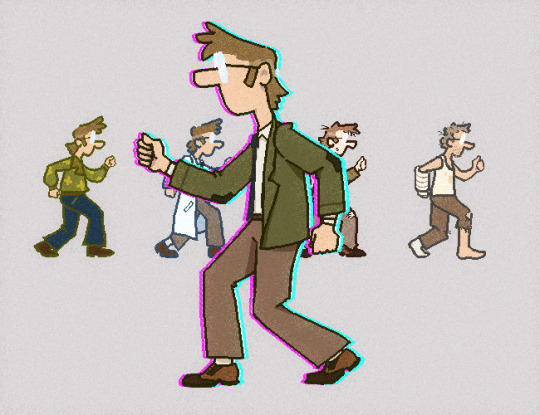
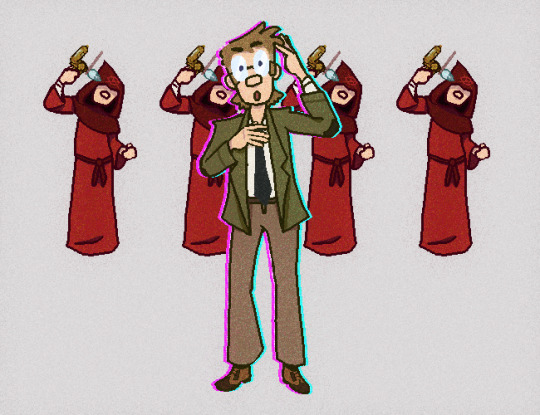
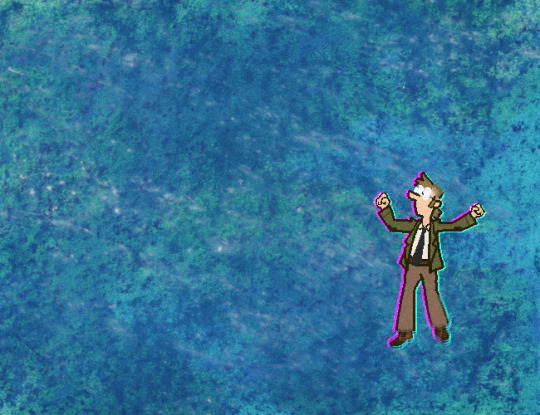
and you may say to yourself: "my god! what have i done?" and you may tell yourself: "this is not my beautiful wife!" and you may tell yourself: "this is not my beautiful house!" and you may ask yourself: "well, how did i get here?"
time isn't holding up, time isn't after us, time is a pony ride! (images described in alt text)
#gravity falls#fiddleford mcgucket#LETTING THE [FIDDLEFORD FRI]DAYS GO BY#“sir it's tuesday” i know. my computer has been busted for two weeks so i couldn't post them when i wanted to. just let me have this#again still new to alt text. i like being a little bit silly but let me know if it gets in the way of accessibility#artwork of the damned#uhhhh yeah this is actually something ive kind of wanted to draw for years now#favorite guy + favorite band = prime high-effort meme material#also. for the record. yes i have a mcgucket playlist. yes it has three talking heads songs on it. no none of them are “once in a lifetime”#also also i know that the lyrics in the description are in the wrong order. it's on purpose. i put them backwards for dramatic effect#also also also i'm pretty sure the “time is a pony ride” line is not actually sung on the album version of the track#but if you listen to/watch the live version from “stop making sense” you will hear it!#as well as hear a much more satisfying ending to the song imo. rather than it just fading out it has some really nice vocals#basically the moral of this story is you should watch “stop making sense”#if you made it to the end of the tags: congrats! you win a prize! the prize is permission to reblog this post
2K notes
·
View notes
Text
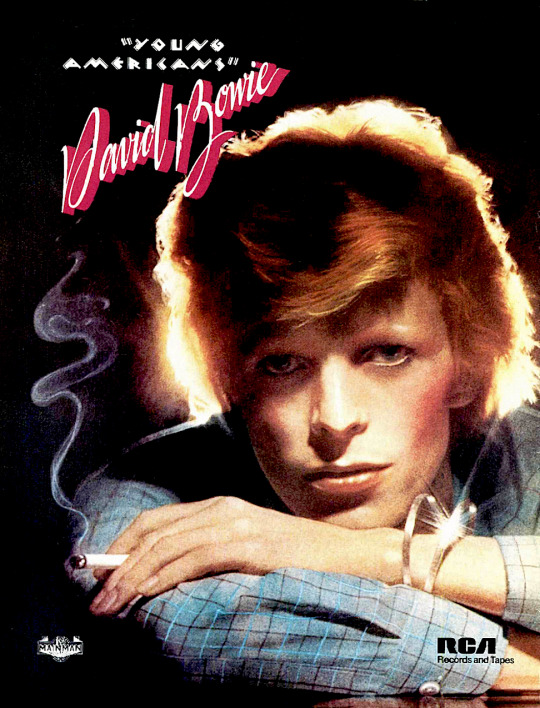
Promo ad for David Bowie’s Young Americans LP - 1975.
#magazines#vintage magazines#music magazines#music#musicians#music industry#recording industry#record labels#recording studios#songwriters#composers#singers#bands#music producers#rca records#70s music#the 70s#the 1970s#record albums#vinyl records#vinyl#lps#vintage advertising#rca records & taps#david bowie#young americans
208 notes
·
View notes
Text
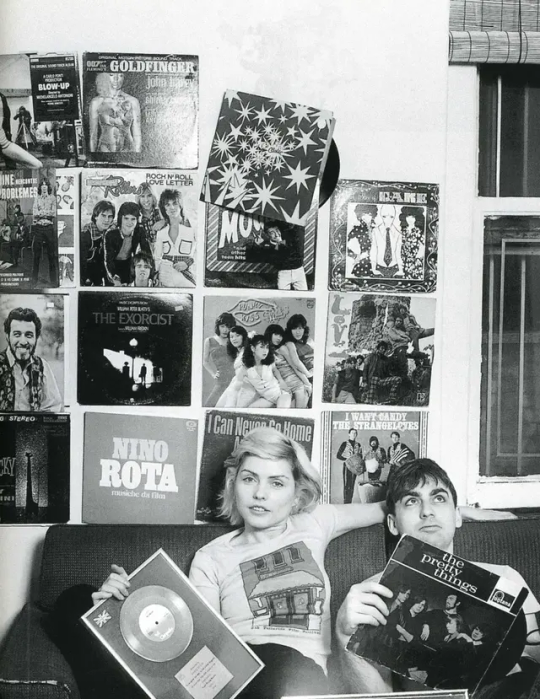
Debbie Harry and Chris Stein photographed in their apartment, New York ♡
#debbie harry#chris stein#1970s#seventies#blondie#blondie band#vinyl#records#vinyl records#fashion#70s#1970s fashion#new wave#photography#photoshoot#punk girl#aesthetic#vintage#old school cool#style#70s style#70s fashion#70s aesthetic#70s girl#70s music#women in music#female musicians#disco#vintage style#rock photography
290 notes
·
View notes
Text

Ann & Nancy Wilson signing records to promote Heart’s album “ Dreamboat Annie” in Seattle Washington 1975
152 notes
·
View notes
Text


#the sisters of mercy#sisters of mercy#sisters#trad goth#goth music#goth aesthetic#gothic#goth#artwork#art#merciful release#80s music#80's#80s nostalgia#1980s#80s bands#80s#80#cover art#vinyl cover#record cover#cover#80s aesthetic#eighties#80s rock#80's music#vintage#80s goth#80's goth
560 notes
·
View notes
Text



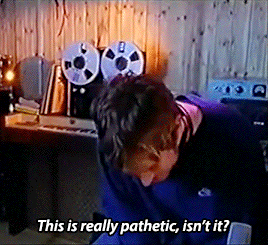
I remember watching The South Bank Show on The Smiths, 'round at Graham's house. And then Morrissey said something at the end… (1999)
#damon albarn#blur#blur band#britpop#(sorry again for the gif quality. it is quite painful to be obsessed with 90s interviews... and yet. there is flavour.)#s'alright to slag moz off. it's allowed. damo gets quite darling and petty after but with moz no one's gonna stop him.#can tell from the sweatshirt the hair the twinkle in his eyes that this is also when he was recording the hand clapper demo#what a special breed '99 damon is#mystuff
816 notes
·
View notes
Text

💿 SUNROT Band Merch
Along with some band tees, these posters and albums were available at the SUNROT merch booth at Edgewave Fest 2024.
5 items — 2 wall decor, 3 misc decor
Find in catalog by searching 'sunrot'
⤷ simfileshare • patreon
SUNROT Poster — Wall decor, §20 "A band poster that was tucked into a zine you picked up at SUNROT's merch booth during Edgewave Fest 2024."

SUNROT Poster Set — Wall decor, §20 "A couple of band posters that were tucked into a zine you picked up at SUNROT's merch booth during Edgewave Fest 2024."

SUNROT CD Display — Misc decor, §100 "Limited edition CDs of SUNROT's most recent album. These were available for sale at the merch booth during Edgewave Fest 2024. Now they can be displayed on your collector's shelf (or the bookcase in the corner of your bedroom)."

SUNROT CD Stack — Misc decor, §50 "Limited edition CDs from SUNROT's discography. The most recent album was picked up from the merch booth at Edgewave Fest 2024."

SUNROT Record Crate — Misc decor, §100 "Records from the band SUNROT. The most recent album was purchased at the merch booth at Edgewave Fest 2024."

This is my first time sharing buy/build recolors so please don't hesitate to let me know if there are any issues 🥰
#sims 4#sims 4 cc#ts4cc#sims 4 download#misc download#sunrot#m#some recolors for moody teens or budding garage bands or alt retail stores#(made sure the CDs and records could be set for sale)#(also removed all the buffs so they're just neutral decor sims can look at)
267 notes
·
View notes
Text
sunshine ghoulette out in tha garden while her mates r out performing... what music do u think shes listening to?!?!

#ghost bc#the band ghost#ghost fanart#nameless ghouls#namelessghoulettes#sunshine ghoulette#sunshine ghost#ghoulette#nameless ghoulettes#(its the one recording of per aspera ad inferi)#(yknow the one)#➥☀️
167 notes
·
View notes